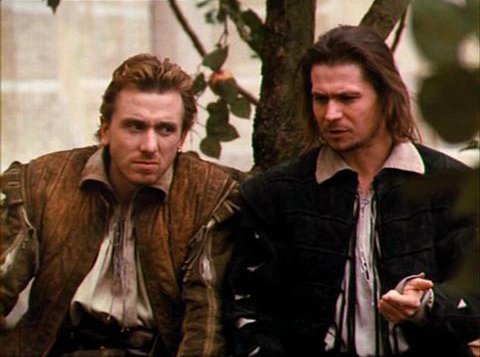“Rosencrantz & Guildenstern Are Dead” (1990) – 3.5/5 Stars
Tom Stoppard’s “Rosencrantz & Guildenstern Are Dead” is a brilliant existential twist on a classic story (Shakespeare’s “Hamlet”) and classic storytelling. It’s sharp, witty, well-acted and thought-provoking in any number of ways, being both memorably absurd and surprisingly truthful.
It’s hard to scrutinize, but the truth is that Stoppard’s Tony-winning 1968 play doesn’t offer an ounce of proof as to why it belongs on the screen. It’s a contemplative story, one that’s heavy and dependent on dialogue. It’s the struggle of all stage-to-screen adaptations, but where others have succeeded in shedding new light through that transition, Stoppard’s re- imagining of his own work lacks a visual edge, perhaps explain why he never took up the director’s chair again.
The story follows “Hamlet” characters Rosencrantz (Gary Oldman) and Guildenstern (Tim Roth), two remarkably unimportant characters from the play who are part of the tragedy’s final body count for no reason other than being at the wrong place at the wrong time. Stoppard’s story explores the play from their perspective: Were they even aware of what was unfolding around them? What was the point of them being there — their purpose? Why did they die? These questions also fuel the film.
Stoppard paints them as goofball characters that despite great wit and sophistication, remain completely oblivious to everything around them until it’s too late and their prescribed fate takes over. Roth and Oldman handle these extremely random conversations that bounce between the literal and figurative playfully yet with great strength. They’re a heck of a duo. Rosencrantz also has a knack for discovering basic laws of physics but then losing them amidst his and Guildenstern’s struggle to figure out what exactly it is they’re doing in all of this Hamlet business. Stoppard uses these examples and a fitting opening bit about the probability of a coin flip to suggest the conflict between randomness and order in life and nature.
Also significant is the group of traveling tragedians led by Richard Dreyfuss, who end up being the ones to put on the play that Hamlet uses to catch his Uncle Claudius realizing his sin. They add the element of theater and tragedy into the meditative stew, reminding us that this story (“Hamlet”) is indeed a work of fiction that was created to a purpose. He preaches in fate, that in tragedy everyone who dies dies because that is what’s expected of them.
It’s a real head-churner, but as philosophically impressive as it is, none of that juicy thought is derived from the visual experience of the film. What characters say in this film is ten times more important than what they do, or namely how they do it. Stoppard throws in some smaller visual elements and undoubtedly he must’ve added something to the screenplay that wasn’t on the stage. After all, he had nearly 20 years to think about his work between the play and the film, so naturally he would’ve wanted to make some changes. But nothing about the way he films this story enhances the existential dialogue between characters as well as between film and audience.
Having never seen the play, “Rosencrantz & Guildenstern Are Dead” was an enjoyable, thought-provoking film experience, but I would imagine having already been exposed to its meta-exploratory ingenuity, those coming to the film with previous exposure might not feel anything more fulfilling than simply seeing it in a three-dimensional world.
3.5/5 Stars
“Rosencrantz & Guildenstern Are Dead” (1990)
Written and Directed by Tom Stoppard
Starring: Gary Oldman, Tim Roth, Richard Dreyfuss





0 Comments
You can be the first one to leave a comment.